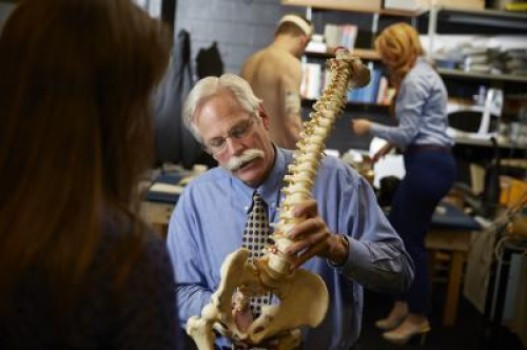
Contrary to popular belief, spooning is not always the best sex position for those with a bad back, according to new research from the University of Waterloo.
For the first time ever, scientists have successfully documented the way the spine moves during sex and discovered exactly why certain positions are better than others when it comes to avoiding back pain.
“Any family doctor will tell you that couples often ask them how to manage their back pain during and after sex. Many couples will remain celibate because one night of love-making can lead to months of back agony,” said Professor Stuart McGill, of Waterloo’s Faculty of Applied Health Sciences. “Until now, doctors have never had any hard science to base their recommendations upon.”
The pioneering study combined infrared and electromagnetic motion capture systems — like those used in the creation of video games — to track how 10 couples’ spines moved when attempting five common sex positions. The findings were used to create an atlas, or set of guidelines, that recommends different sex positions and thrusting techniques based on what movements trigger a patient’s pain.
“Before now, spooning was often recommended by physicians as the one position that fit all. But as we’ve discovered, that is not the case,” said Natalie Sidorkewicz, a PhD candidate at Waterloo and lead author on the paper. “Sex positions that are suitable for one type of back pain aren’t appropriate for another kind of pain.”
The atlas recommends that men who are flexion-intolerant — meaning those whose back pain is made worse by touching their toes or sitting for long periods of time, for example — replace spooning with doggy-style sex. The guide recommends that these men use a hip-hinging motion rather than thrusting with their spines.
“For the first time ever, we now have very solid science to guide clinicians on their recommendations for patients who suffer debilitating back pain, but still want to be intimate,” said Sidorkewicz. “This has the potential to improve quality of life — and love-life — for many couples.”
According to Statistics Canada, four of every five people will experience at least one episode of disabling low back pain in their lifetime. Up to 84 per cent of men with low back pain and 73 per cent of women report a significant decrease in the frequency of intercourse when suffering back pain.
The study also shed light for the first time on the mechanics of the male orgasm. Electrodes hooked up to the male participants’ muscles revealed that it is abdominal and buttock, not back muscles, that are most active during orgasm. Spine motion, on the other hand, varied with the individual. For some males, a drastic increase in flexion or extension was seen, while for others spine motion did not change much at all.
“Many of the back pain patients that we see have told us that they experience elevated levels of pain during orgasm, to the point where they will avoid having one during sex with their partner,” said Sidorkewicz. “These initial findings help us to begin to understand what might be provoking their pain during the moment of climax.”
A paper documenting male spine movement was published in the journal Spine. Female findings are expected to be published in the coming months. The next phase of the study will involve recruiting patients with hip pain and additional categories of back pain to further develop the guidelines.
Story Source:
The above story is based on materials provided by University of Waterloo. Note: Materials may be edited for content and length.
Journal Reference:
- Natalie Sidorkewicz et al. Male Spine Motion During Coitus: Implications for the Low Back Pain Patient. Spine, September 2014
